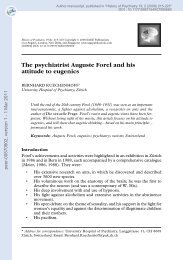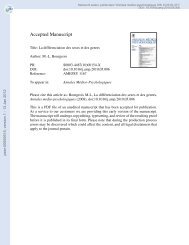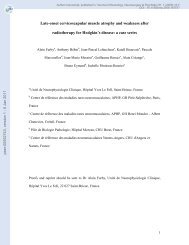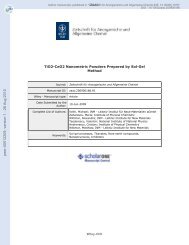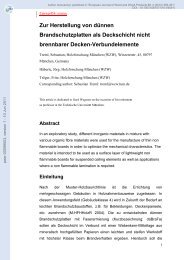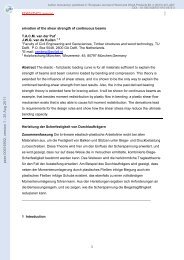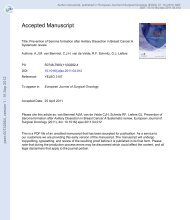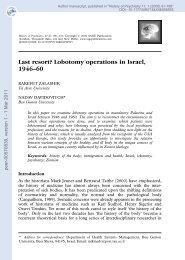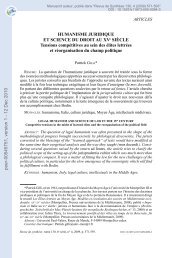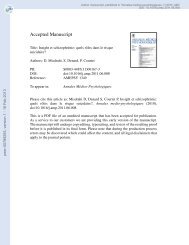Cosheaves and connectedness in formal topology
Cosheaves and connectedness in formal topology
Cosheaves and connectedness in formal topology
You also want an ePaper? Increase the reach of your titles
YUMPU automatically turns print PDFs into web optimized ePapers that Google loves.
Let us call such a po<strong>in</strong>t t strongly top. We shall prove (Theorem 39) that<br />
a lower powerpo<strong>in</strong>t is a positivity predicate iff it is strongly top <strong>in</strong> the lower<br />
powerlocale. This result is already known [5], but we shall give a proof that is<br />
more categorical as a pattern for the correspond<strong>in</strong>g discussion of cosheaves <strong>in</strong><br />
Section 7.2.<br />
Lemma 37. Let X = (P, ≤, ⊳ 0 ) be a flat site, <strong>and</strong> let F be a lower powerpo<strong>in</strong>t.<br />
Then F is a positivity predicate iff RestF = X.<br />
Proof. ⇒: The covers a ⊳ {a} ∩ F present<strong>in</strong>g RestF already hold <strong>in</strong> X.<br />
⇐: For any F , the sublocale RestF is overt, so X is overt. The positivity<br />
predicate for RestF is F , which is thus also the positivity predicate for X.<br />
peer-00821313, version 1 - 9 May 2013<br />
Lemma 38. Let X = (P, ≤, ⊳ 0 ) be a flat site, <strong>and</strong> let F, G : W → P L X be<br />
two generalized lower powerpo<strong>in</strong>ts. Then F ⊑ G iff Rest W F ≤ Rest W G (as<br />
subspaces of X × W ).<br />
Proof. Note that Rest W F ≤ Rest W G iff there is a (unique) map Rest W F →<br />
Rest W G over X ×W , <strong>and</strong> by def<strong>in</strong>ition of Rest W G as comma object this holds if<br />
p F ; ↓ ⊑ q F ; G : Rest W F → P L X. (p F <strong>and</strong> q F are the projections from Rest W F<br />
to X <strong>and</strong> W .)<br />
⇒: This is the easy way round. If F ⊑ G then p F ; ↓ ⊑ q F ; F ⊑ q F ; G.<br />
⇐: We first prove this <strong>in</strong> the case W = 1. S<strong>in</strong>ce Rest W F ≤ Rest W G, the<br />
positivity predicate for Rest W F is <strong>in</strong>cluded <strong>in</strong> that for Rest W G: <strong>in</strong> other words,<br />
F ⊑ G. But that argument is constructive <strong>and</strong> hence applies also for <strong>in</strong>ternal<br />
locales <strong>in</strong> SW , i.e. maps with codoma<strong>in</strong> W . Let us apply it to X × W , with its<br />
projection down to W . The geometricity of P L [6] tells us that, construct<strong>in</strong>g P L<br />
<strong>in</strong>ternally <strong>in</strong> SW , we have (P L ) W (X ×W ) ∼ = P L X ×W . In this context we have<br />
global lower powerpo<strong>in</strong>ts of X × W , namely 〈F, W 〉, 〈G, W 〉 : W → P L X × W .<br />
Let us calculate the Rest sublocale for 〈F, W 〉, the comma object<br />
q<br />
C −→ W<br />
↓ p ⊑ W ↓ 〈F, W 〉<br />
X × W P L X × W<br />
−→<br />
↓×W<br />
(The subscript W <strong>in</strong> ⊑ W denotes that the order between maps to P L X × W<br />
has to restrict to equality when projected down to W .) A po<strong>in</strong>t of C is a<br />
triple 〈x, w 1 , w 2 〉 such that ↓ x ⊑ F (w 2 ) <strong>and</strong> w 1 = w 2 , so C ∼ = Rest W F as<br />
def<strong>in</strong>ed above. Hence our work<strong>in</strong>g <strong>in</strong> SW shows that if Rest W F ≤ Rest W G<br />
then 〈F, W 〉 ⊑ 〈G, W 〉 over W , i.e. F ⊑ G.<br />
Theorem 39. Let X = (P, ≤, ⊳ 0 ) be a flat site, <strong>and</strong> F a lower powerpo<strong>in</strong>t.<br />
Then the follow<strong>in</strong>g are equivalent.<br />
1. X is overt, with F its positivity predicate.<br />
2. RestF = X.<br />
3. F is strongly top <strong>in</strong> P L X.<br />
26



